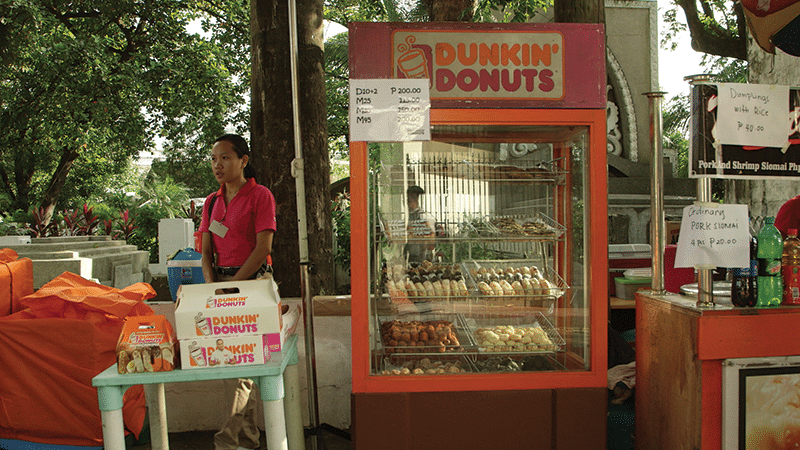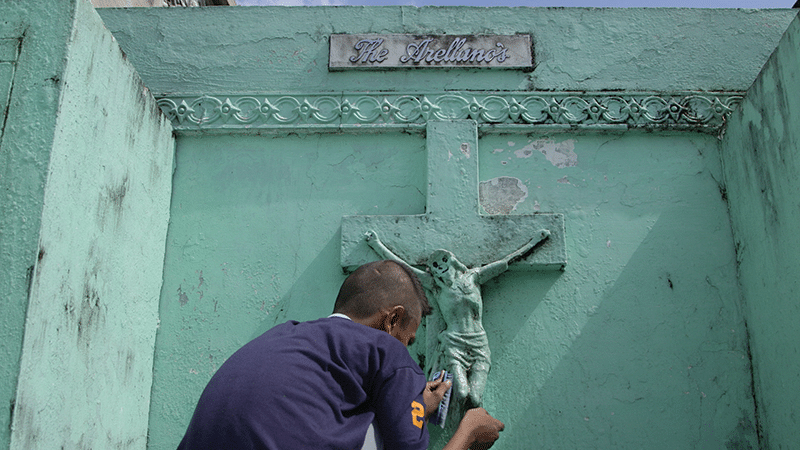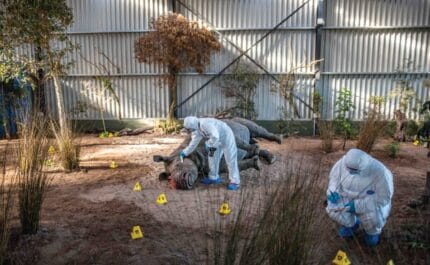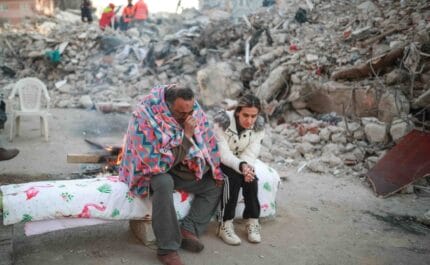A grave situation
The city of Manila has one of the highest rates of homelessness in the world. In issue #18 of Delayed Gratification, Stephanie Beeston reported on the cemetery in the Filipino capital which has become a shelter and a home to 7,000 people

6th March 2015 (Taken from: #18)
On 18th January 2015, thousands of Filipinos lined the route to Rizal Park where Pope Francis conducted the largest outdoor mass in history. Addressing a sea of blue and yellow ponchos on a rainy Sunday afternoon, the man known locally as ‘Lolo Kiko’ or ‘grandfather Francis’ called on the crowd of six million, urging them to shun “the social structures which perpetuate poverty, ignorance and corruption”.
As millions of devotees chanted the pope’s name, less than five miles away Tony Bacalso, 62, watched attentively on his son’s seven-inch portable television with his family. He would have loved the opportunity to see the pope in person but it wasn’t possible. “We’d have the cost of travelling there. That, and I have problems with my knees. So I just said that seeing him on TV would be enough,” he explains.
Tony has the look of a man who is long overdue a rest. For nearly three decades he has worked as a caretaker in Manila North, one of the oldest and largest public cemeteries in the Filipino capital. With more than twenty mausoleums under his care, he walks the streets of the cemetery with a casualness that makes it easy to forget that he is surrounded by tens of thousands of stone-encased corpses. This is probably because Manila North has not only been Tony’s workplace for the past 28 years but also his home. Along with his family he lives in a mausoleum known only by its family name, Arrieta – which also happens to be where my great-grandmother is buried.

A cot is suspended mid-air inside a mausoleum that doubles up as a family home
Originally built as a final resting place for the affluent families of the capital, Manila North is now better known for its thriving population of the living who have colonised the cemetery and transformed it into a hidden city within a city. There are no official figures on how many people live here, although a common estimate among residents is around 7,000. A large proportion of this population work as caretakers, a term for live-in families who occupy the mausoleums dotted throughout the cemetery. With the permission of the families who own each plot, residents tread a fine line between maintaining these mausoleums as respectful places for the dead and functional homes for the living.
The first time I met the Bacalso family was in September 2013. Walking down 9th Street, a narrow alleyway littered with trampled flowers, I came across Tony dozing in the afternoon heat on a broken patio chair. Upon noticing me he quickly jumped into life, ushering me into the Arrieta mausoleum where he introduced me to his wife Ching, his children Jayson and Gerald, Gerald’s girlfriend Sheila and their sons James and Ivan.
Having long lost contact with the Arrieta side of my family, I surveyed the mausoleum for the first time in silent bewilderment. It was a grandiose mix of marble floors and brass carvings with enough room for around 50 deceased occupants. In one corner stood a bed topped with a simple quilt. Nestled next to it was a plastic chest of drawers and a frayed baby walker: both gifts from machantes, Tony explained, the term caretakers use for the mausoleum owners who employ them.
Tony grew up in Tondo, one of the most underdeveloped areas in metropolitan Manila. After skipping through a string of jobs during his twenties he eventually ended up in the cemetery at his sister’s suggestion. “She told me, ‘Tony, you must move to the cemetery while you don’t have a job to pay for the rent.’ She accompanied me to the cemetery and introduced me to her friends. They gave me a place to live. That was in 1987.”

Tony (centre back) and members of his family
For Tony and the other residents of Manila North, life is surprisingly ordinary. For 364 days of the year mausoleums are not cold reminders of the departed but practical and often inventive family homes. Numerous shops in different burial ground neighbourhoods stock all the necessities one could need, from toilet paper to fresh vegetables. A freelance beautician wanders the streets offering manicures and haircuts. ‘Jumpers,’ entrepreneurial young electricians, scramble across mausoleum rooftops rerouting power lines to provide paying residents with electricity. As we spoke, a neighbour played an Avril Lavigne album loudly for the third or fourth time that day. “If living outside the cemetery means having a television, we can have televisions here. They have radios on the outside – I also have a radio! You should think as if you’re still living on the outside,” remarked Tony.
A tomb with a view
For the Bacalsos, life amongst the dead is not only completely normal but a necessity for survival. Their main source of income is an annual caretaking stipend from their machantes. The fee varies depending on mausoleum size but is usually between 600 pesos (£9) and 2,000 pesos (£30) a year per mausoleum.
This alone is never enough to feed his family, so to supplement his income Tony plays a waiting game. From his spot on 9th Street he tracks the arrivals of funerals or new visitors in the hope of extra paid work, in the form of grave-digging, mausoleum construction or even exhuming bodies. There is a well-used phrase in the cemetery to describe this kind of work: “hanap patay”. A play on the Tagalog word for livelihood, literally translated it means “searching for death”.
“We need dead people to live. Dead people are our source of income,” Tony told me. “You keep your hopes high that at least someone might come each day. If you’re unlucky, then tomorrow is another day. You can’t tell when the opportunity will come. You just want to be there when it does.”
Earning a living in the cemetery is becoming harder. The burgeoning population means more competition from younger and fitter caretakers. With unused space in the cemetery diminishing there is less new work available. There’s also the basic fact that people are living longer. All this presents a predicament for older caretakers, who recognize that their livelihoods are at stake but are unable to take steps to protect themselves. As Tony observed, “My only job is when someone dies. But am I going to pray that someone should die so I can earn a living?”
We need dead people to live. Dead people are our source of income”
With lives so heavily reliant on chance, a stint of bad luck means caretakers are forced to look elsewhere to make ends meet. This has resulted in an upsurge of moneylending businesses that are widely used by caretakers as a reliable but risky way of surviving the year. Lenders operate on what is known as the ‘5-6’ scheme, an established informal arrangement whereby the borrower takes five pesos and, in principle, pays back six. In reality interest rates are much steeper than this, usually hovering around the 50 percent mark.
Caretakers like Tony are thankful for the financial support moneylenders provide, despite the fact that it is precisely this help that creates an ongoing cycle of debt in the cemetery. With few other options available, borrowing becomes inevitable. As Tony says, “when you’re gripping the knife’s edge, you have no choice but to give in.”
The one opportunity for caretakers to move beyond their reliance on lenders and earn decent money is during the period leading up to All Saints Day on 1st November. On this day, families visit the graves of their loved ones to celebrate their lives and pay their respects. As one of the biggest cemeteries in the city, Manila North sees an enormous influx of people. Last year it was estimated that two million people walked through the cemetery gates over the holiday weekend.

On the night before All Saints Day a Dunkin’ Donuts is set up on the roadside in North Manila in anticipation of the deluge of visitors who will descend upon the cemetery the following day
The religious and social significance of the holiday means that caretakers have their work cut out for them. It’s a mark of status to keep a family mausoleum well-maintained, so in the weeks leading up to All Saints Day, Tony and his sons spend hours scrubbing and sanding, hiding a year’s worth of neglect under a fresh lick of paint. It’s a real opportunity for them to increase their chances of receiving a good tip, or even find new machantes to work for.
As All Saints Day arrives, beds, toys and makeshift kitchens are hidden away and mausoleums revert back to being places for the dead. The streets of the cemetery are filled with hundreds of stalls selling everything from Disney character balloons to cell phone plans. Restaurants including Pizza Hut and Dunkin’ Donuts vie for business amongst the chaos of family reunions and candlelight vigils. For residents it is the most exciting day of the year, but also one fraught with tension and financial uncertainty.
In the days after All Saints Day, things begin to calm down. Residents return to their homes, unpack their belongings and get back to the normal routine. It is at this point that families anxiously total up their earnings from the past month and find out whether they have scraped together enough to pay off their creditors. The 100-metre journey to the moneylender’s mausoleum-cum-office is the furthest I ever see Tony venture out of his neighbourhood.
A utopian message
The pope’s visit came at a poignant time for the Philippines, a country in the midst of considerable socioeconomic change. The national economy has flourished in recent years; in the last quarter of 2014 it reached 6.9 percent, making it Asia’s second-fastest growing economy.

Jayson at work in the cemetery
On the streets of Manila, however, this apparent growth is often invisible. An estimated quarter of the population still lives in poverty, with around 35 percent residing in informal settlements like Manila North. Large swathes of the population are at risk of sliding into malnutrition. Unless measures are brought in to create economic opportunity across society and encourage growth from the bottom as well as the top, it’s hard to see how the pope’s utopian demand – to abolish the structures that perpetuate poverty – can be achieved any time soon. Until then, the future for families like the Bacalsos lies here, amongst the dead.
When I revisit the Bacalsos after the pope’s trip to Manila, their situation has worsened. Ching has had to stop working due to failing health and Tony’s arthritis has become more severe. Worse still, their son Jayson has been hospitalised for a month. In order to keep up with hospital bills and medication Tony increased his borrowing limits and now owes more than 31,000 pesos (around £470) to a series of lenders.
The future for families like the Bacalsos lies here, amongst the dead”
Joining him at his regular spot, I ask him if he’s likely to be able to pay it all back. “I’m not sure,” he answers bluntly. “And if I can’t meet the deadline, they might add interest to my remaining balance.” He’s only too aware of the financial difficulties he is likely to face, but feels powerless to take action. “I can’t control the situation any more. It’s the situation controlling me.”
As we talk, Tony sits atop an unassuming concrete box wedged between two old mausoleums. Inside are the remains of his daughter and mother. This is the only place he could think of to bury them. Without knowing it, you’d walk right by these modest graves, distracted by the grandeur and intricacy of the mausoleums that tower over them. Even in death, the disparity between the rich and poor is palpable.
But in typical Filipino fashion, there is an upside to all of this. Those who choose to make the cemetery their permanent residence are rewarded with a deep familiarity with the place where they will eventually be buried. They will have the ultimate benefit of staying truly close to home – and to their families. As Tony points out with a rare grin, “When I die, my family will still feel like I’m here with them… because I’ll still live here.”
Slow Journalism in your inbox, plus infographics, offers and more: sign up for the free DG newsletter. Sign me up
Thanks for signing up.








